Author Archive
 A Better Antenna for Dualband Handhelds
A Better Antenna for Dualband Handhelds
I’m a fan of using a half-wave antenna on a 2m handheld transceiver (HT). These come in a variety of forms but I’ve tended to use the telescoping half-waves that mount on the HT. These include the Halfwave 2 Meter Flex antenna from Smiley and the MFJ-1714 from MJF. One of the disadvantages of these two antennas is that they are designed for 2m operation only. Put it on a dualband HT and you can only use one of the bands.
Now there is a dualband alternative.

During a discussion of various VHF radios and antennas on the SOTA reflector, Phil/G4OBK recommended this antenna: TWAYRDIO RH 770 SMA-Male Dual Band Telescopic Handheld Antenna. I was mildly skeptical in that the antenna looks like cheap lowcost economy stuff from China. However, for $16.55 (free shipping), it seemed like something I should try out.
I’ve since used this antenna on several SOTA activations and have found it to work quite well. Not having to worry about whether I’m operating on 2m or 70 cm is a big plus. I liked the antenna so much, I now have three.
Recently, I wondered how well the antenna is really performing so I did a side-by-side comparison with the Smiley 2m halfwave. Now this kind of comparison is always a bit dicey unless you have a calibrated antenna range. I got on 2m fm with another ham running a home station some distance away such that I was not pegging his S-meter. We did several A/B comparisons between the Smiley and the RH 770. Much to my surprise, the RH 770 performed significantly better than the Smiley. The other ham saw his meter deflect higher with the RH 770. I can’t give that to you in dB but I can say its a little better. I actually thought that the single-band design might be slightly better due to less complexity in the antenna. The opposite was true. Your mileage may vary. No warranty expressed or implied.
The only thing I don’t like about the RH 770 is that the telescoping sections slide up and down really easy. Too easy for my taste. I’d rather have some stickiness to it so that I am sure it will remain fully extended. But I admit this is more of a personal impression than actual problem.
The antenna is available with a male SMA connector, a female SMA connector or a BNC. That should pretty much cover it.
So thanks Phil/G4OBK for pointing out this antenna. I also highly recommend it.
73, Bob K0NR
The post A Better Antenna for Dualband Handhelds appeared first on The KØNR Radio Site.
 FM VHF: The Utility Mode
FM VHF: The Utility Mode
 I’ve been referring to the VHF FM as the utility mode for quite a while now. I picked this up from Gary Pearce/KN4AQ when I inherited the FM column from CQ VHF magazine (no longer being published). Gary recently filled me in on the origin of this term, which he captured in his first FM column for CQ VHF.
I’ve been referring to the VHF FM as the utility mode for quite a while now. I picked this up from Gary Pearce/KN4AQ when I inherited the FM column from CQ VHF magazine (no longer being published). Gary recently filled me in on the origin of this term, which he captured in his first FM column for CQ VHF.
Gary describes how he got hooked on VHF operating, especially 2m FM:
I’ve been a ham since 1965 (age 15). Today, I have an Extra class license, and I operate some HF (mostly SSB and digital, with cw limited to occasional bouts at Field Day). But since my first days as a Novice with a Heathkit Twoer, I’ve been a VHFer. I went through the 2 and 6 meter AM days with a Heath Seneca and Utica 650, and then SSB with a Gonset Sidewinder and Hallicrafter HA-2 transverter. But what really flipped my switch as an early ham was an old, single-channel Motorola 80D on 146.94 simplex, installed in the car of a teenage friend’s father. For you newer hams, this is an exercise in nostalgia that I don’t have space here to explain – I wish I could. I will note that the Motorola 80D was an FM radio that began life in a police car or taxi cab somewhere. It was a huge, heavy, all-tube radio that sat in the trunk and improved traction on the ice. Below the dash was a control head with volume, squelch, and the microphone and speaker.
It wasn’t long before I learned about repeaters, which enhanced the FM experience immeasurably (all four of them in the Chicago area at the time). My interest in VHF SSB waned…Getting involved in a local repeater group felt comfortable – this was someplace where I could really participate.
But then things shifted as time passed. Gary wrote:
While I wasn’t looking, FM became just another mode. At least that’s the consensus I got from some of the guys who have been doing Amateur Radio publishing a lot longer than I have…
Some columns devoted to sub-sets of Amateur Radio have lasted for decades. VHF-UHF is one. That’s the weak-signal side of VHF, not the FM side. Digital modes go through enough reincarnations to keep interest up. DX, contesting, QRP, holding their own.
But not FM/Repeaters? QST editor Steve Ford, WB8IMY, suggested why, and gave me the idea for this column’s “Utility Mode” tag line. He said, “Our research has shown that while FM users comprise a very large portion of the amateur community, the majority tend to perceive their FM activity more as a ‘utility’ function rather than a hobby.”
FM VHF is arguably the most common mode used in amateur radio. (Can I back that up with reliable data? Not sure, but I’m pretty sure it’s true.) I do see where it fits into the concept of a utility function or utility mode. Think about the electrical system in your house (a utility). For the most part, you just plug things in and use it but you probably don’t consider yourself a 120 VAC hobbyist. Well, a few of you might but that’s another issue. FM VHF is a lot like that…most hams have it and they just use it without too much consideration. Push the button and it works.
But that definition is a little bit derogatory…FM VHF is just there and no one appreciates it. The Eeyore of ham radio modes.
Another definition of utility (as an adjective) is:
Utility: having or made for a number of useful or practical purposes rather than a single, specialized one:
This fits my perception of FM VHF: very useful for many things. Whether you are providing communications for a bike race, handling talk-in for a local hamfest, working the ISS, chatting across town while mobile, the first choice is likely to be 2m (or 70 cm) FM.
And that’s why I’ve always been a FM VHF enthusiast: there are so many things you can do with it. Just use your imagination.
73, Bob K0NR
To see what Gary KN4AQ has been up to lately, visit HamRadioNow.
The post FM VHF: The Utility Mode appeared first on The KØNR Radio Site.
 Top Five Underrated K0NR Blog Posts
Top Five Underrated K0NR Blog Posts
 Normally at the end year, I list the five blog posts that got the most hits during the year. It turns out that this list does not change a lot from year to year. For completeness and consistency, these are the top five posts for 2017, in rank order:
Normally at the end year, I list the five blog posts that got the most hits during the year. It turns out that this list does not change a lot from year to year. For completeness and consistency, these are the top five posts for 2017, in rank order:Choose Your 2m Frequency Wisely , Getting Started on 2m SSB , Can I Use My Ham Radio on Public Safety Frequencies? , DMR Hotspot from SharkRF and Introducing the Android HT
What I’m doing different this year is to list the five posts that I think readers should read but haven’t made the most hit list. This is based on my personal opinion but what the heck. You’ll see a theme of trying to make sense of how amateur radio fits into our modern world.We’ve Got Some Explaining to Do
Amateur Radio is Not for Talking
That’s Not Real Ham Radio
Is the Internet Destroying Amateur Radio?
Amateur Radio: Narrowband Communications in a Broadband WorldHere is a sixth bonus article…very interesting story about Prisoners of War building radios in World War II.
POW Canteen Radio73 and Happy New Year! Bob K0NR The post Top Five Underrated K0NR Blog Posts appeared first on The KØNR Radio Site.
 Amateur Radio: Narrowband Communications in a Broadband World
Amateur Radio: Narrowband Communications in a Broadband World
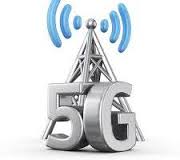 For my day job in the test and measurement industry, I get involved in measurement solutions for wireless communications. Right now, the big technology wave that is about to hit is known as 5G (fifth generation wireless). Your mobile smartphone probably does 4G or LTE as well as the older 3G digital mobile standards. For more detail on LTE, see ExtremeTech explains: What is LTE?
For my day job in the test and measurement industry, I get involved in measurement solutions for wireless communications. Right now, the big technology wave that is about to hit is known as 5G (fifth generation wireless). Your mobile smartphone probably does 4G or LTE as well as the older 3G digital mobile standards. For more detail on LTE, see ExtremeTech explains: What is LTE?
5G will be the next cool thing with early rollouts planned for 2018. The design goals of 5G are very aggressive, with maximum download speeds of up to 20Gb/s. (See what I did there: I used the words “up to”, so don’t expect this performance under all conditions.) The actual user experience has yet to play out but we can assume that 5G is going to be blazing fast. For more details see: Everything You Need to Know About 5G. To achieve these high bandwidths, 5G will use spectrum at higher frequencies. Move up in frequency and you inherently get more bandwidth. The FCC recently allocated 11 GHz of new spectrum for 5G, including allocations at 28 GHz, 37 GHz, 39 GHz and 64-71 GHz: FCC 5G spectrum allocation demands 3 breakthrough innovations . Yes, those frequencies are GHz with a G…that’s a lot of cycles per second.
Amateur Radio
So my day job is focused on wider bandwidths and higher frequencies. Then I go home and play amateur radio which is a narrowband, low frequency activity. The heart of ham radio operation is on the HF bands, 3 to 30 MHz, almost DC by 5G standards. Many of us enjoy VHF and UHF but even then most of the activity is centered on 50 MHz, 144 MHz, maybe 432 MHz. I recently started using 1.2 GHz for Summits On The Air, so that at least gets me into the GHz-with-a-G category.
Not only does ham radio stay on the low end of the frequency range, we also use low bandwidth. The typical phone emission on the HF bands is a 3-kHz wide SSB signal. That’s kHz with a k. As we go higher in frequency, some of our signals are “wideband” such as a 16-kHz wide FM signal on the 2m band. In terms of digital modes, AX.25 packet radio and APRS typically use 1200 baud data rates but sometimes we go with a “super-fast” 9600 transmission mode. CW is still a very popular narrowband mode with bandwidths around 200 Hz, depending on Morse code operating speed. Lately, the trend has been to go even narrower in bandwidth to keep the noise out and operate at amazingly low signal-to-noise ratios. Some of the WSJT modes use bandwidths in the range of 4 to 50 Hz.
There are some good reasons that amateur radio remains narrowband. The two most important are:
- We love the ionosphere and what it does for radio propagation. The HF bands are great for making radio signals go around the world but they are narrow spectrum. For example, the 20m band is 350 kHz wide, going from 14.000 to 14.350 MHz. Operation is restricted to narrowband modes, else we’d use up the entire band with just a few signals.
- We just want to make the contact (and maybe talk a bit). For the most part, radio hams are just trying to make the contact. This is most pronounced during a DX pileup or during a contest when you’ll hear short exchanges that provide just the minimal amount of information. Some of us like to talk…rag chew…but that can be accomplished with narrowband (SSB) modulation with no problem. I suppose it would be handy from time to time to be able to send a 3 MB jpg file to someone I am working on 20m but that’s not the main focus of a radio contact.
Of course, not all amateur radio operation is below 1 GHz. There’s always someone messing around at microwave and millimeter wave frequencies. I’ve done some mountaintop operating at 10 GHz and achieved VUCC on that band. Recently, the ARRL announced a new distance record of 215 km on the 47 GHz band.
ICOM produced a D-STAR system at 1.2 GHz with a data rate of 128kbps, quite the improvement over AX.25 packet. However, adoption of this technology has been very limited and it remains a single-vendor solution.
There is significant work going on with High-Speed Multimedia (HSMM) Radio which repurposes commercially-available 802.11 (“WiFi”) access equipment. Broadband-Hamnet is focused primarily on using 2.4 GHz band to create mesh wireless mesh networks. Amateur Radio Emergency Data Network (AREDN) is doing some interesting work, mostly on the 2.4 GHz and 5.8 GHz bands. The HamWAN site has lots of information about a 5.8 GHz network in the Puget Sound area. The basic theme here is use commercial gear on adjacent ham bands…a common strategy for many VHF and higher ham radio systems.
Also worth mentioning is the FaradayRF work, currently aimed at creating a basic digital radio for the 33cm (902 MHz) amateur band. The raw data transfer rate is around 500 kbaud.
There are probably some other high-speed digital systems out there that I’ve missed but these are representative.
Infrastructure Rules
A critical factor in making LTE (and 5G) work is the huge investment in infrastructure by Verizon, AT&T and others. With cellular networks, the range of the radio transmission is limited to a few miles. One of the trends in the industry is toward smaller cells, so that more users can be supported at the highest bandwidths. With 5G moving up in frequency, small cells will become that much more important.
On the other hand, most amateur radio activity is “my radio talking to your radio” without any infrastructure in between. Most of us like the purity and simplicity of my station putting out electromagnetic waves to talk directly to fellow hams. In many cases, this simplicity and robustness has played well under emergency and disaster conditions.
FM (and digital voice) repeaters are a notable exception with the Big Box on the Hill retransmitting our radio signal. For decades now, FM repeaters have represented an infrastructure that individual hams and (more often) radio clubs put in place for use by the local ham community. There is a trend towards more infrastructure dependency in ham radio as repeaters are linked via the internet via IRLP, EchoLink and other systems. (Some hams completely reject any kind of radio activity that relies on established infrastructure, often claiming that it is irrational, unethical or just plain wrong.)
One interesting area that is growing in popularity is the use of hotspots (low power access points) for the digital voice modes (D-STAR, DMR, Fusion, etc.) In this use model, the ham connects a hotspot to their internet connection and talks to anyone on the relevant ham network while walking around the house with a handheld transceiver. See the Brandmeister web site to see the extend of this activity. It strikes me that this is the same “small cell” trend that the mobile wireless providers are following. You want good handheld coverage? Stick a hotspot in your house.
Looking at ham radio and broadband communications, I summarize it like this:
- The vast majority of ham radio activity is narrowband oriented, for reasons described above.
- There is some interesting ham radio work being done with broadband systems, mostly on 2.4 GHz and 5.8 GHz.
- Commercially available broadband technology (LTE, 5G, and beyond) will continue to increase total network bandwidth and performance increasing the difference between commercial broadband and narrowband ham radio.
Implications
The reason for writing this article is that the amateur radio community needs to recognize and understand this increasing bandwidth gap. We like to talk about the cool and exciting stuff we do with wireless communications but we need to also appreciate how this is perceived by someone with an LTE phone in their pocket. Just communicating with someone at a distance is no longer novel. After all, Amateur Radio is Not for Talking.
What do I conclude about this? Here’s a few options:
1. Don’t worry. We are all about narrowband and that’s good enough. This attitude might be sufficient as there are tons of fun stuff to do in this narrowband world. In terms of ham radio’s future, this implies that we need to expose newcomers to narrowband radio fun. We’ll need to get better at talking about how amateur radio makes sense in this broadband world.
2. Embrace commercially available broadband. Use it where it makes sense. This approach means that Part 97 remains mostly narrowband but we can make use of the ever-improving wired and wireless network infrastructure that is available to us.
3. Develop Part 97 ham radio broadband. I am initially a bit skeptical of this idea. How the heck does ham radio compete with the billions of dollars Verizon, AT&T and others poor into broadband wireless? But that may not be the point. Once again, I fall back to the universal purpose of amateur radio: To Have Fun Messing Around with Radios. Can we have fun building out a broadband network? Heck yeah, that sounds like an interesting challenge. Would it be useful? Maybe. Emergency communications might be an appropriate focus and some hams are already working on that. Create a network that operates independent from the commercial internet and make it as resilient as possible.
I think Option #3 is definitely worth considering. What do you think?
73, Bob K0NR
The post Amateur Radio: Narrowband Communications in a Broadband World appeared first on The KØNR Radio Site.
 Radio Frequency Interference From 12V-to-USB Adapters
Radio Frequency Interference From 12V-to-USB Adapters
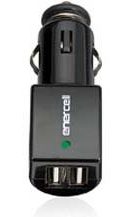 Many small electronic devices have switching regulators in them that can generate a bunch of Radio Frequency Interference (RFI). This is not my first encounter with RFI-spewing devices. See this article about a automotive 12V-to-USB adapter giving me trouble: This Interference Seems To Follow Me Everywhere
Many small electronic devices have switching regulators in them that can generate a bunch of Radio Frequency Interference (RFI). This is not my first encounter with RFI-spewing devices. See this article about a automotive 12V-to-USB adapter giving me trouble: This Interference Seems To Follow Me Everywhere
I recently bought a couple of adapters that are physically larger than the one I wrote about. I was thinking that a larger size might allow for a little more filtering and a design that does not radiate. I was half right: one of them works pretty well, the other is an RFI Bad Boy.
Take a look at this short video where I check them out.
This is an Amazon link to the adapter that works pretty well.
Enercell® 2-Port USB CLA Car Charger
73, Bob K0NR
The post Radio Frequency Interference From 12V-to-USB Adapters appeared first on The KØNR Radio Site.
 General License Class: Black Forest, CO Feb 24/Mar 3
General License Class: Black Forest, CO Feb 24/Mar 3
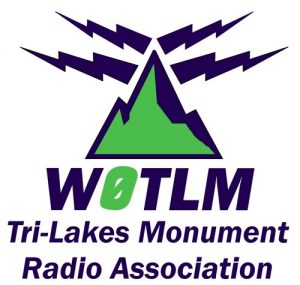 Sat Feb 24 and Sat Mar 3 (8 AM to 5 PM) 2018
Sat Feb 24 and Sat Mar 3 (8 AM to 5 PM) 2018
Black Forest Fire Station
11445 Teachout Road
Colorado Springs, CO 80908
The General License provides access to regional and worldwide communications on the HF bands, greatly expanding your ham radio fun!
• Upgrade from Technician to General Class radio privileges
• Pass your FCC General Class amateur license exam Mar 10*
• Live equipment demonstrations and activities
• Learn to operate on the HF bands, 10 Meters to 160 Meters
• Gain a deeper understanding of radio electronics and theory
• Take the next step with antennas, amplifiers, digital modes
Registration fee: $30 ($20 for under 18 years of age)
Students must have the required study guide: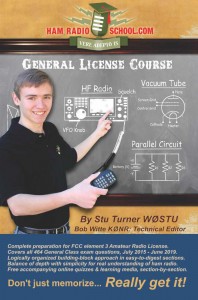
HamRadioSchool.com General License Course
Second Edition, effective 2015 – 2019, $22.95
* Free FCC exam session on Mar 10 at Black Forest Fire Station 9:30 am.
To register for the class, email: Bob KØNR bob@k0nr.com
Sponsored by the Tri-Lakes Monument Radio Association
The post General License Class: Black Forest, CO Feb 24/Mar 3 appeared first on The KØNR Radio Site.
 Pikes Peak SOTA (W0C/FR-004) Winter Activation
Pikes Peak SOTA (W0C/FR-004) Winter Activation
Joyce/K0JJW and I had intended to hike Pikes Peak this year for a Summits On The Air (SOTA) activation but somehow the plan never came together. I still had my eye on it as a drive-up activation before the end of 2017. The road to the summit is open year round now but closes frequently due to snowstorms passing through. Saturday morning the road was open to 13 miles (out of 19 miles) with the promise that it would be open to the summit later in the morning. (Call 719 385-7325 for a recorded message on road conditions.) By the time we got to the toll gate around 10 am, the road was open to the summit.
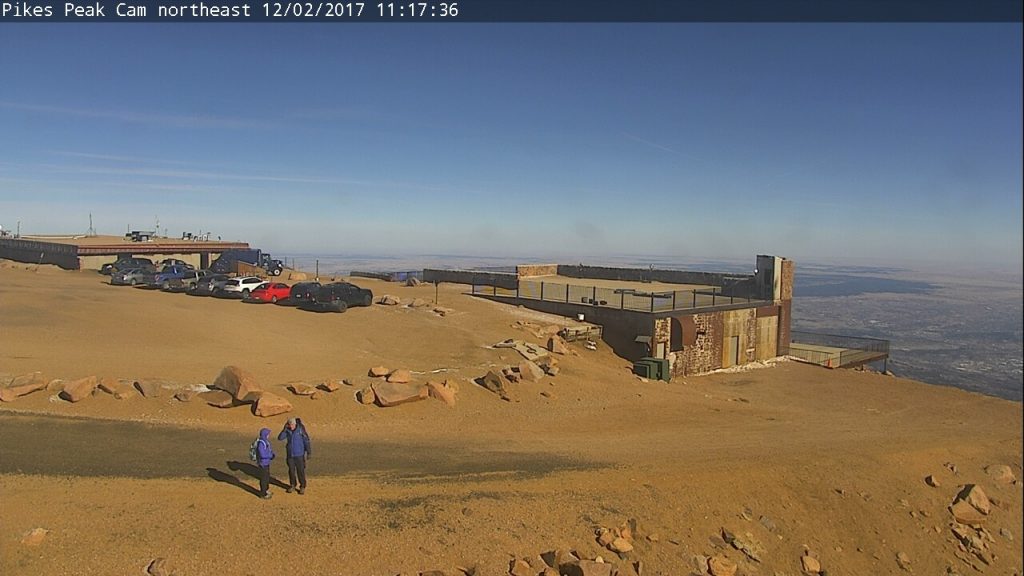
When we reached the summit, the weather conditions were 20 deg F with 20 mph winds, creating a windchill of 4 deg F. We were prepared for that having loaded up on the winter clothing. Still, it was freaking cold up there. As you can see in the webcam picture, there was only traces of snow on the summit.
To be SOTA-compliant, we had all of our gear loaded into our packs and walked some distance away from our vehicle to set up. Because of the wind, we chose the observation platform, tucked in behind one of the walls. Normally, that platform is to be avoided because its overrun with tourists but with the cold weather we only had a few people to contend with.

Joyce set up on 2m fm (146.52) using a handheld transceiver (HT) with a vertical antenna. Even with her headset (foam protection on the microphone), the wind noise on her signal was significant. I started out on 2m fm but quickly moved up to 223.5 MHz and worked a few stations there, then on to 446.0 MHz. I had HTs and small yagi’s on both of those bands. Then I fired up 1.2 GHz with an Alinco HT (just 1W on that band) and a 16-element yagi. I worked Paul/W0RW, Gary/WB5PJB and Wayne/N0POH on that band. My QSO with N0POH in Aurora was a new personal best for distance on 23cm/1.2 GHz, at about 90 km.
I tried 2m SSB using my FT-817 but made only one contact: Jim/WB0GMR. Shortly thereafter, I switched back to 2m fm using the 25W mini-mobile rig with a 3-element yagi to work many more stations. Again, just running a bit of power and having a decent antenna on 2m fm was very effective at making radio contacts. I expected the Tytera radio to be overloaded with signals on the summit of Pikes but it actually held up well with just occasional bursts of interference.
Overall, we made 54 QSOs (not too shabby): 43 QSOs on 2m, 5 QSOs on 70cm and 3 QSOs on both 1.25m and 23cm. Our best DX was Jeff/N0XLF near Akron, CO for a distance of about 130 miles (on 2m and 70cm).
73, Bob K0NR
The post Pikes Peak SOTA (W0C/FR-004) Winter Activation appeared first on The KØNR Radio Site.












